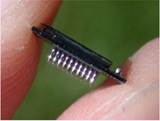Controlling prostheses with nerve impulses Innovation Award for Nerve-Computer Coupling

Patients who have lost significant parts of a hand, arm or leg will one day have more control over their prostheses by means of nerve signals. A nation-wide research group that has developed an extremely promising project to make this a reality yesterday received the Innovation Award for Medical Technology from the German Federal Ministry for Research and Education.
Patients who have lost a hand can already control their prosthesis by means of electrical signals relayed from the muscles in their forearms. But what happens if the forearm has also been lost? Around the world, high-profile research groups are attempting to design a “brain-computer interface”. Using the system, the patient thinks of a movement and electrodes attached to the head would record the brain waves. A computer then attempts to interpret the information by filtering the matching signals from the noise of the brain waves and triggering the corresponding movement in the hand. The process is laborious, prone to errors and slow. Approximately 10 seconds lie between a thought and action.
“However, using the remaining nerves instead of the brain to trigger movement is a viable alternative," explains Dr. Schulte-Mattler from the Universität Regensburg. Here, researchers are attempting to wrap the nerve ends in a special foil, which is then used to relay the electrical impulses to, and thereby control, a prosthesis. The foil contains circuit traces and a microchip. , whereby the nerve endings (axons) are in electrical contact with the circuit traces and the chip then sends the received information on to the prosthesis. Technology similar to RFID is employed for this. The chip is powered by an external inductor. “In comparison to brain waves, we understand what individual nerve signals mean relatively well” says Schulte-Mattler. RFID technology is extremely widespread and familiar to most from electronic bar codes.
But the devil is in the details. Under which conditions do axons grow best in the exogenous material? Is the contact continuous or does the body reject the connection after a time? How does the foil with its circuit traces and the chip behave in tissue? These and similar questions will now be answered in a two-year research project to help develop the first foundations for a "nerve-computer interface". To answer the technical questions, Fraunhofer IZM can make use of several years of experience in this area. Together with Fraunhofer IBMT and the company Otto Bock, a peripheral nerve interface for the wireless transmission of control impulses to "intelligent" prostheses has already been developed in the USA with the University of Utah, Salt Lake City.
“Directly connecting such an interface would also be possible," explains Prof. Michael Töpper. However, in this case, wires would lead from the nerves from the inside of the arm stump or even the brain to a type of plug on the surface of the tissue, which would pose a substantial risk of infection. For this reason, the Berlin researchers are developing a wireless array. A hundred needle-thin sensor tips will be pressed into the tissue. When a nerve cell then sends a signal in the form of a tiny electrical impulse, the sensor tips receive the electrical current. For this they require a direct contact to the transmitting nerve in the brain or the nerve cord.
The rest is state-of-the-art microtechnology: the tips relay the signal to a tiny chip. The chip amplifies the weak signal and sends it on. “As part of the award-winning project, the sensor tips will now be replaced by nano-scale structured electrodes, which will allow for an even smaller interface," according to Töpper. Particularly the microelectronic packaging is a key component of the project because it ensures the bio-compatibility of the entire system through the use of special materials such as parylene. “By integrating microelectronic technologies in a variety of ways, such as on flexible circuit boards, as well as microsystem technology itself, further opportunities for future development in medical technology will be created.”
The research alliance led by the Neurological University Clinic includes the Fraunhofer Institute for Reliability and Microintegration IZM in Berlin (Dr. Stefan Fiedler), the Technical University Berlin with its key research area Microperipheral Technologies (Dr. Thomas Löher) and the Universität Rostock, Chair for Biophysics (Institute for Biomedical Sciences, Prof. Dr. Jan Gimsa). Prof. Dr. Hans Wolf from the Institute for Medical Microbiology at the Universität Regensburg brought the right people together at the right time.
Last modified:
 Fraunhofer Institute for Reliability and Microintegration IZM
Fraunhofer Institute for Reliability and Microintegration IZM